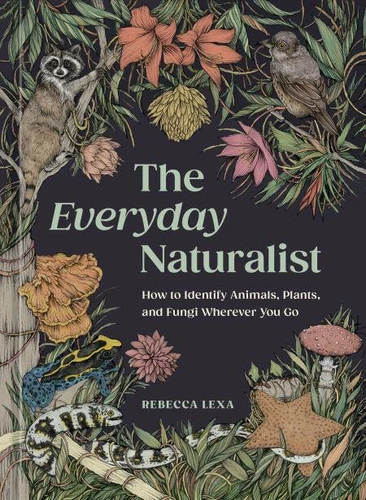The Everyday Naturalist. How to Identify Animals, Plants, and Fungi Wherever You Go
Par : ,Formats :
Disponible dans votre compte client Decitre ou Furet du Nord dès validation de votre commande. Le format ePub protégé est :
- Compatible avec une lecture sur My Vivlio (smartphone, tablette, ordinateur)
- Compatible avec une lecture sur liseuses Vivlio
- Pour les liseuses autres que Vivlio, vous devez utiliser le logiciel Adobe Digital Edition. Non compatible avec la lecture sur les liseuses Kindle, Remarkable et Sony
- Non compatible avec un achat hors France métropolitaine
 , qui est-ce ?
, qui est-ce ?Notre partenaire de plateforme de lecture numérique où vous retrouverez l'ensemble de vos ebooks gratuitement
Pour en savoir plus sur nos ebooks, consultez notre aide en ligne ici
- Nombre de pages272
- FormatePub
- ISBN978-0-593-83598-2
- EAN9780593835982
- Date de parution17/06/2025
- Protection num.Adobe DRM
- Taille54 Mo
- Infos supplémentairesepub
- ÉditeurTen Speed Press
Résumé
Learn to identify animals, plants, and fungi wherever you go with this step-by-step guide for spotting and recording key traits and characteristics. If you've ever consulted a field guide to identify a new bird at your feeder, you know the process isn't as easy as it sounds. In fact, it seems like you have to know a lot about that mystery bird to even figure out where to start. The Everyday Naturalist fills in the gaps by explaining what traits to pay attention to when encountering a new species; how and when to use field guides, apps, and other resources; what to do if you get stuck; and more.
Rather than focusing on one region or continent, these skills and tools are designed to help you classify nature anywhere you are-whether on familiar territory, traveling, or in a new home. In chapters about animals, plants, fungi, and organisms like lichens and slime molds, naturalist and guide Rebecca Lexa goes into detail about what sets each of these kingdoms apart from each other-from color, shape, and texture to reproductive characteristics, behavior, and habitat-and includes more than forty full-color photos and drawings to illustrate key points.
She also provides detailed case studies to demonstrate how to use all of these traits to identify specimens across multiple kingdoms. This easy-to-follow guide empowers you to learn more about the species around you, then use what you know to preserve the world you love. And at a time when biodiversity is imperiled worldwide, nature needs more advocates than ever.
Rather than focusing on one region or continent, these skills and tools are designed to help you classify nature anywhere you are-whether on familiar territory, traveling, or in a new home. In chapters about animals, plants, fungi, and organisms like lichens and slime molds, naturalist and guide Rebecca Lexa goes into detail about what sets each of these kingdoms apart from each other-from color, shape, and texture to reproductive characteristics, behavior, and habitat-and includes more than forty full-color photos and drawings to illustrate key points.
She also provides detailed case studies to demonstrate how to use all of these traits to identify specimens across multiple kingdoms. This easy-to-follow guide empowers you to learn more about the species around you, then use what you know to preserve the world you love. And at a time when biodiversity is imperiled worldwide, nature needs more advocates than ever.
Learn to identify animals, plants, and fungi wherever you go with this step-by-step guide for spotting and recording key traits and characteristics. If you've ever consulted a field guide to identify a new bird at your feeder, you know the process isn't as easy as it sounds. In fact, it seems like you have to know a lot about that mystery bird to even figure out where to start. The Everyday Naturalist fills in the gaps by explaining what traits to pay attention to when encountering a new species; how and when to use field guides, apps, and other resources; what to do if you get stuck; and more.
Rather than focusing on one region or continent, these skills and tools are designed to help you classify nature anywhere you are-whether on familiar territory, traveling, or in a new home. In chapters about animals, plants, fungi, and organisms like lichens and slime molds, naturalist and guide Rebecca Lexa goes into detail about what sets each of these kingdoms apart from each other-from color, shape, and texture to reproductive characteristics, behavior, and habitat-and includes more than forty full-color photos and drawings to illustrate key points.
She also provides detailed case studies to demonstrate how to use all of these traits to identify specimens across multiple kingdoms. This easy-to-follow guide empowers you to learn more about the species around you, then use what you know to preserve the world you love. And at a time when biodiversity is imperiled worldwide, nature needs more advocates than ever.
Rather than focusing on one region or continent, these skills and tools are designed to help you classify nature anywhere you are-whether on familiar territory, traveling, or in a new home. In chapters about animals, plants, fungi, and organisms like lichens and slime molds, naturalist and guide Rebecca Lexa goes into detail about what sets each of these kingdoms apart from each other-from color, shape, and texture to reproductive characteristics, behavior, and habitat-and includes more than forty full-color photos and drawings to illustrate key points.
She also provides detailed case studies to demonstrate how to use all of these traits to identify specimens across multiple kingdoms. This easy-to-follow guide empowers you to learn more about the species around you, then use what you know to preserve the world you love. And at a time when biodiversity is imperiled worldwide, nature needs more advocates than ever.



